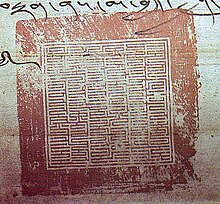Khoshut Khanate
Based in modern Qinghai, it was founded by Güshi Khan in 1642 after defeating the opponents of the Gelug school of Tibetan Buddhism in Tibet.
Güshi Khan accepted the nominal suzerainty of the Qing dynasty in 1654, when seal of authority and golden sheets were granted by the Shunzhi Emperor.
The Khoshut Khanate was ended in 1717 when the Dzungar prince Tseren Dondup invaded Tibet, killed Lha-bzang Khan, and installed the 7th Dalai Lama.
During the Toluid Civil War, the Four Oirat (Choros, Torghut, Dörbet, and Khoid) sided with Ariq Böke and therefore never accepted Kublaid rule.
The Oirats held sway over the Northern Yuan khans until the death of Esen Taishi in 1455, after which they migrated west due to Khalkha Mongol aggression.
[3] In 1620, the leaders of the Choros and Torghut Oirats, Kharkhul and Mergen Temene, attacked Ubasi Khong Tayiji, the first Altan Khan of the Khalkha.
Tso Ngonpo) was being repressed by the Khalkha Choghtu Khong Tayiji, who aided their rivals the Karmapa and Bön sects.
After a short visit to Tibet in 1635, the next year, Güshi led 10,000 Oirats in an invasion of Qinghai which resulted in the defeat of a 30,000 strong enemy army and the death of Choghtu.
He then entered Central Tibet, where he received from the 5th Dalai Lama the title of Bstan-'dzin Choskyi Rgyal-po ("the Dharma King Who Upholds the Religion").
He married the khan's daughter Amin Dara, and was sent back to establish the Dzungar Khanate on the upper Emil River south of the Tarbagatai Mountains.
His sixth son Dalai Baatar was given control of Kokonor while Ochirtu was left in temporal power as Khan of the Oirats.
However according to a memorial dated 27 June 1703, the 6th Dalai Lama had informed the Khoshut that he intended to remove Sangye Gyatso as regent.
[17] According to a memorial dated 11 June 1704, the 6th Dalai Lama had a good relationship with the khan and joined him in hunting and practicing archery.
[11] According to Peter Schwieger, Lha-bzang sought the support of the Kangxi Emperor of the Qing dynasty, who requested that he send the 6th Dalai Lama to Beijing.
[21] In 1717, the Dzungar prince Tseren Dondup invaded the Khoshut Khanate, deposed Yeshe Gyatso and installed the boy from Lithang as the 7th Dalai Lama, killed Lha-bzang Khan, and looted Lhasa.
[23] The Ganden Phodrang, named after the 5th Dalai Lama's residence in Drepung Monastery, was set up as a Gelug led government of Tibet in 1642.
The Khoshut Khanate played a pivotal role in its founding by defeating the enemies of the Gelug school and part of the Ganden Phodrang's military defense continued to be handled by the Mongols after its establishment.
According to Glenn Mullin, Güshi Khan was the appointee of three Mongol chieftains to represent their interests in Tibet and after having finished his business he returned to rule in Kokonor.
[12][28] FitzHerbert and Travers describe an increase in the 5th Dalai Lama's "day-to-day control of... his government" after the deaths of Sonam Rapten and Güshi Khan in the 1650s.
[29] The key role of Güshi Khan in the rise of the Ganden Phodrang was celebrated by annual state ceremonies as late as the 20th century.
During the Monlam Prayer Festival, people wore Mongol-style military clothing in the style of Güshi Khan's troops.



